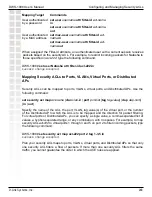
228
DWS-1008 User’s Manual
D-Link Systems, Inc.
Configuring and Managing IGMP Snooping
DWS-1008 User’s Manual
Configuring Static Multicast Ports
A DWS-1008 switch learns about multicast routers and receivers from multicast traffic it
receives from those devices. When the switch receives traffic from a multicast router or
receiver, the switch adds the port that received the traffic as a multicast router or receiver
port. The switch forwards traffic to multicast routers only on the multicast router ports and
forwards traffic to multicast receivers only on the multicast receiver ports.
The router and receiver ports that the switch learns based on multicast traffic age out if they
are unused. You can add network ports as static multicast router ports or multicast receiver
ports. Ports you add do not age out.
Note. You cannot add access ports or wired authentication ports as static multicast ports.
However, MSS can dynamically add these port types to the list of multicast ports based on
multicast traffic.
Adding or Removing a Static Multicast Router Port
To add or remove a static multicast router port, use the following command:
set igmp mrouter port
port-list
enable
|
disable
Adding or Removing a Static Multicast Receiver Port
To add a static multicast receiver port, use the following command:
set igmp receiver port
port-list
enable
|
disable
Displaying Multicast Information
You can use the CLI to display the following IGMP snooping information:
• Multicast configuration information and statistics
• Multicast queriers
• Multicast routers
• Multicast receivers
Displaying Multicast Configuration Information and Statistics
To display multicast configuration information and statistics, use the following command:
show igmp
[
vlan
vlan-id
]
The
show igmp
command displays the IGMP snooping state, the settings of all multicast
parameters you can configure, and multicast statistics.






























